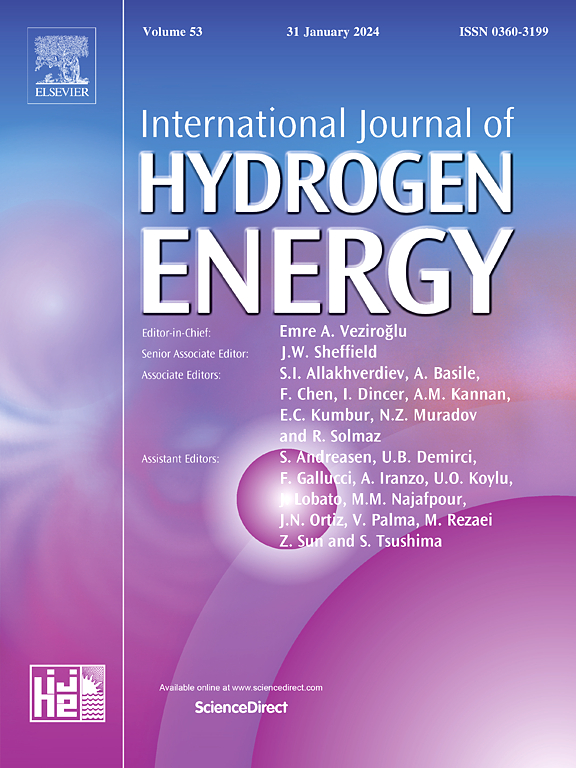Synergistic enhancement of hydrogen storage performance in Mg-based composites with high-entropy alloys
IF 8.1
2区 工程技术
Q1 CHEMISTRY, PHYSICAL
引用次数: 0
Abstract
The body-centered cubic (BCC) high-entropy alloys (HEAs) TiCrVM (M = Fe, FeCo, FeZr) with high hydrogen storage capacity are introduced to Mg to address the challenges of sluggish kinetics and high thermodynamic stability in Mg-based hydrogen storage materials. The five-element HEA TiCrVFeCo exhibits superior effect compared to TiCrVFeZr and TiCrVFe. The TiCrVFeCo reduces the dehydrogenation activation energy of MgH2 from 183.4 kJ/mol to 81.1 kJ/mol and lowers the onset dehydrogenation temperature by 119 °C, from 324 °C to 205 °C. The composite exhibits a high γ-MgH2 phase content (24.0 wt%) and ultrafine particle size (∼91.3 nm), contributing to a reduced dehydrogenation enthalpy (ΔH = 62.5 kJ/mol). Researches reveal that the in-situ formed Mg2CoH5 hydride act as “hydrogen pump”, facilitating electron transfer at Mg/HEA interfaces. The TiCrVFeCo alloy's high hardness (48.5 HRC) and hydrogen-driven pulverization resistance during reactive milling further enhance particle refinement and γ-MgH2 formation.

高熵合金协同增强镁基复合材料储氢性能
将具有高储氢能力的体心立方(BCC)高熵合金(HEAs) TiCrVM (M = Fe, FeCo, FeZr)引入Mg,解决了Mg基储氢材料动力学缓慢和热力学稳定性高的难题。与TiCrVFeZr和TiCrVFe相比,五元HEA TiCrVFeCo表现出更好的效果。TiCrVFeCo使MgH2脱氢活化能从183.4 kJ/mol降低到81.1 kJ/mol,脱氢起始温度从324℃降低到205℃,降低了119℃。该复合材料具有高γ-MgH2相含量(24.0 wt%)和超细粒度(~ 91.3 nm),有助于降低脱氢焓(ΔH = 62.5 kJ/mol)。研究表明,原位形成的Mg2CoH5氢化物起到了“氢泵”的作用,促进了Mg/HEA界面的电子转移。在反应铣削过程中,TiCrVFeCo合金的高硬度(48.5 HRC)和抗氢驱动粉碎性能进一步增强了颗粒细化和γ-MgH2的形成。
本文章由计算机程序翻译,如有差异,请以英文原文为准。
求助全文
约1分钟内获得全文
求助全文
来源期刊

International Journal of Hydrogen Energy
工程技术-环境科学
CiteScore
13.50
自引率
25.00%
发文量
3502
审稿时长
60 days
期刊介绍:
The objective of the International Journal of Hydrogen Energy is to facilitate the exchange of new ideas, technological advancements, and research findings in the field of Hydrogen Energy among scientists and engineers worldwide. This journal showcases original research, both analytical and experimental, covering various aspects of Hydrogen Energy. These include production, storage, transmission, utilization, enabling technologies, environmental impact, economic considerations, and global perspectives on hydrogen and its carriers such as NH3, CH4, alcohols, etc.
The utilization aspect encompasses various methods such as thermochemical (combustion), photochemical, electrochemical (fuel cells), and nuclear conversion of hydrogen, hydrogen isotopes, and hydrogen carriers into thermal, mechanical, and electrical energies. The applications of these energies can be found in transportation (including aerospace), industrial, commercial, and residential sectors.
 求助内容:
求助内容: 应助结果提醒方式:
应助结果提醒方式:


